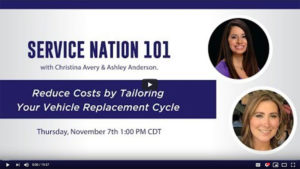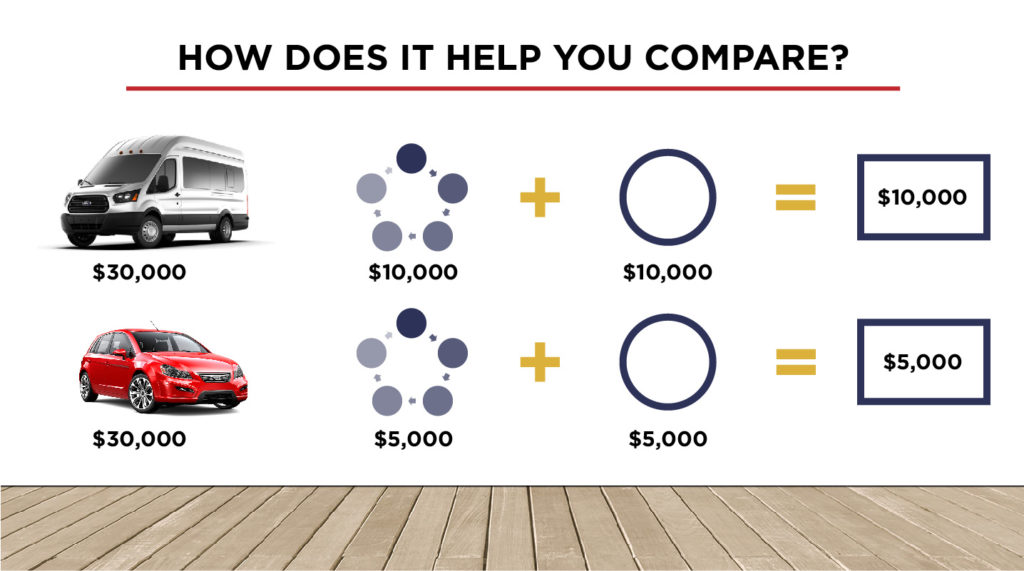5 Things Every Business Should Know Before They Buy or Lease Their Vehicles. Please fill out the form to download the PDF.

Service Roundtable is an organization comprised of HVAC, plumbing, electrical, and other contracting companies. Members join to collaborate and learn about best practices for their business: including marketing, operations, and other practices that can increase their profitability. Leasing Associates was invited to present on Service Nation 101 on how to determine a vehicle replacement strategy.
Highlights from Service Nation 101 Webinar:
When we talk about replacing vehicles, we look at the full lifecycle, from cradle to grave. In other words, from acquisition, to the resale or remarketing of the vehicle.
Often, companies will take a reactionary course of action by solely looking at factors like the economy, safety issues, age or mileage, or costly repairs. The best plan for replacement of vehicles is one that is strategic and looks at all factors involved in replacing. We have all heard the term: “Drive it till the wheels fall off”, which is not economically sound nor safe for drivers.
Focusing on age or mileage is one of the most common methods used. It’s simple but has some disadvantages. If you rely solely on age or mileage, other conditions within the fleet are not accounted for. For instance, less reliable vehicles could be kept in service longer than they should and incur costly repairs. And, other vehicles could be removed while still having plenty of service life left in them.
When appropriate, extending vehicle lifecycles can be advantageous. Its important to look at the utilization, operating costs, and the amount of time you are planning on extending the replacement cycle.
Economic drivers of replacement decision
There are many variables that affect decisions to replace. Minimizing vehicle downtime has become one of, if not the biggest goals companies try to achieve, since a vehicle down means lost revenue.
Depreciation
Depreciation is the largest expense a fleet will incur. Depreciation is essentially loss in value. We all know the minute we drive off the lot, we are already at a loss. Keeping a close eye on how much each vehicle depreciates and its resale value, will give you the information to make better informed decisions on when to replace.

What is the 5-year cost to own?
The 5-year cost to own is the total amount of vehicle-related costs you will likely have to cover during the first 5 years of service. This includes out of pocket expenses like fuel and insurance, state fees, Preventative maintenance such as oil changes, brakes etc., PLUS vehicle depreciation.


How does it help you compare?
Look at both vehicles, both have the same purchase price. But if you notice the 2nd vehicle only incurred 5,000 in expenses and depreciated 5,000. The 2nd vehicle retained more of its worth & depreciated less than the 1st vehicle. There are various reasons for this, but as an example, it could be that the 2nd vehicle has better fuel economy, and fuel prices are on the rise. Consequently, there is a high demand for fuel efficient vehicles.
Tools that will help your company
Kelly blue book–is a valuation and automotive research company that is used widely by both consumers and automotive industry personnel. You can use this tool to gather info on best time to buy and evaluate the worth of current vehicle.
Edmunds–Research new and used vehicles, check pricing, view incentives and dealer inventory listings, compare vehicles, get car buying advice and reviews.
It’s important to do some research on Kelly blue book and Edmunds, you may even want to consult a leasing or fleet management company. After some research and detailed analysis, you will be able to make better informed decisions on what vehicle to acquire.
Now the Question is, how long are you going to keep it?
Extended replacement cycles
Can extending vehicle replacement save money in the long run? It all depends. Today, manufacturers have improved quality, warranties have extended, and vehicles are more dependable than they were 20 or even 10 years ago. If you hold onto a vehicle too long, there is too much uncertainty in the market and its very likely that you will experience diminishing gains on the sale of the vehicle, paired with unforeseen and unscheduled maintenance. The downtime outweighs holding on to vehicles longer. Downtime equates to $100 an hour that the vehicle is not being driven. Reasons for this is: lost revenue from missed appointments, loss of customer loyalty, and the cost to pay your driver while they are not on the road.
Decreased employee morale
Vehicles can be leveraged to attract and retain good employees. Drivers are also more efficient and take pride in maintaining their vehicles if they are newer and equipped with everything they need for the job like, ladder racks, bins, etc
Safer Vehicles & better fuel economy
Newer vehicles have better safety features, which protect your drivers and the liability of your company. New innovations on vehicle safety have come a long way, such as automatic emergency braking, adaptive cruise control, blind spot monitors, and other features. Employee safety risk can increase due to vehicle breakdowns and other part failures, that can put the driver in highway situations that can be dangerous if they are stranded on the side of the road.
Newer vehicles have better fuel economy vs older vehicles, and fuel is one of the highest operating costs for a fleet. New engine technologies help to improve MPG. As an existing vehicle ages, the fuel economy deteriorates due to increased inefficiency of the aging vehicle. Performance declines as fuel systems and engines age. It may cost more upfront to get new vehicles, but the fuel savings over the life of the vehicle outweigh the cost.
Company Image
Your vehicles are rolling billboards for your company. They represent the service or product that your company provides. Unkempt vehicles are a red flag for potential customers as they correlate the image of your vehicle to the quality of your service. Company vehicles can either entice or turn someone away. A vehicle may be the only thing that someone sees, it could be their first and only impression of the company. Make sure to make this impression count.
Telematics is essentially a GPS tracking device that helps companies see vehicles in real time and get engine diagnostic codes. Route optimization can decrease miles driven. Telematics can help regulate the routes taken by drivers. Telematics can also get insight into unnecessary wear and tear driving habits, such as harsh braking, excessive idling, and unnecessary stops made throughout the day.
Telematics extends the asset’s life, because of the less abusive driving and engine diagnostics. If vehicles are well maintained, they will have a longer service life. When a vehicle goes to auction, a secondary driver will pay higher price if they know the vehicle was maintained and driven with care.
Best time to replace
There are many ways to evaluate replacing but all of them require information and data on the vehicle. A fleet management company can help evaluate replacement cycles. They can automate this process by identifying units that meet an age or mileage and then evaluate whether the repairs are becoming increasingly higher. If a single repair costs over 30% of the vehicle’s fair market value, then it is time to replace this vehicle. A lot of times companies will hold on to vehicles longer, because they have already invested so much money into fixing it, but at some point, it is better to cut losses and stop throwing more money at a depreciating asset.
Why is recycling so important?
Value goes down, and repairs go up. Avoid being stuck in this situation. The best way to avoid this is by cycling vehicles out. Also, companies should have a plan in place to get vehicles cycled out while they are at their highest value and have not yet started to cause expensive repairs or downtime. Companies should factor in maintenance costs, fuel efficiency, usage of vehicle, and order deliver times.
When should you partner with a leasing company?
Leasing Associates has the back-office support and over 60 years of knowledge on vehicles & vehicle replacement strategies. With our assistance and analysis tools, we can help your company decide on the best time to replace vehicles. Vehicles can be overwhelming to handle, but once you partner with us, you can be sure that through our partnership, better vehicle decisions will be made.